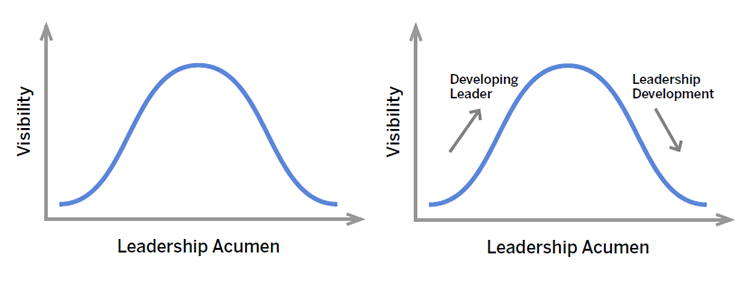Cultivating leaders is one of the best aspects of my job. For the past ten years, I have used the leadership curve to initiate the training with our Campers in Leadership Training (CILT). Our CILTs are youth in their final summer as campers. I am not sure where the idea was created. I may have stolen it from someone else (and if so, I would love to find the person so I can thank him or her for the inspiration), or it came to me as a vision. This past year, I shared the concept with a group of directors and they loved it, so I decided I needed to further share the idea with the camp industry.
It is my belief that one of our biggest roles as leaders is to develop the leadership of those around us. If we are truly selfless leaders, we should strive to get out of the way so others can develop their leadership skills. To help young, aspiring leaders to better grasp this concept, I came up with the leadership curve.
First, let me say there is no research behind this, and I don't have any official degrees or titles to back this up. What I do have is life experience watching effective leaders and watching aspiring leaders as they work with effective leaders.
The leadership curve is a bell curve with leadership acumen on the x-axis and visibility, or "standing in front of the crowd-ness" (for lack of a better term) on the y-axis. As we develop as leaders, we are more prepared to be at the front of the room, to be vocal, and to lead. We see this as young men and women become more comfortable as leaders in school, on the sports field, or in the classroom. As we get older, we see leadership emerge in the board room and on the sales team. The emerging leader is more comfortable sharing his or her thoughts and ideas.
At a point, the emerging leader needs to make the transition into a servant leadership role to help others build their leadership. At camp, this is the older campers sharing the stage with the younger campers so they have an opportunity to experience leadership. We often tell our CILTs that the true evaluation of their performance happens the following summer when we see how the upcoming leaders succeed. This also occurs when the senior staff member steps aside and allows a first-year staff member to share songs and create new traditions. Or when the director accepts suggestions from the junior staff member. This model doesn't work when phrases like "we have tried that already" are often used.

There are three key points to the leadership curve:
- Often there is only so much room for leaders in a group.
Most of us have experienced the veteran staff member who loves the spotlight. They love being the "leader" of the staff. This can be a vital role in your camp community, or it can become a major liability for your camp's culture. These leaders can become "camp smart" and can feel threatened by new leaders in the culture. I have used the leadership curve many times to help a strong leader transition into the servant leader role. It can give the strong leader a sense of purpose and a new identity as a staff developer. - One of our key roles as a leader is to develop people.
Camp is a place for people to "try on" different personalities and leadership styles. We want to teach young men and women that they can indeed be leaders. And we want to teach those people who are natural leaders how they can positively utilize their gifts for good. As leaders ourselves, we want to help younger leaders move their way up the left side of the curve. We want them to experiment with their own leadership styles, experience success in leading, and realize there will be some failures as leaders too. Young men and women have the chance to lead hikes, be the captain of the sports team, plan the canoe trip, or emcee the talent show. - It is more rewarding and impactful to watch others succeed.
The right side of the curve is a wonderful place to live your life as a leader. Just watch the look on the face of a true leader when his or her understudy succeeds. The feeling of witnessing someone else thriving because of your compassion and support far outweighs the feeling of being in front of the crowd.
We move around the leadership curve throughout our lives. We may spend time on the right side of the curve in one area of our lives and then shift to the left side in another area. The visual of the leadership curve has helped me demonstrate the value and importance of growing as a leader, as well as the value of getting out of the way for others to grow.
Jeff Cheley is the fourth generation of his family to operate Cheley Colorado Camps with his sister Brooke Cheley Klebe. He and his wife Erika have three boys, Jackson, Harrison, and Hayden. Jeff enjoys the challenge of developing others, the strategy of business, and a well hit golf shot.


